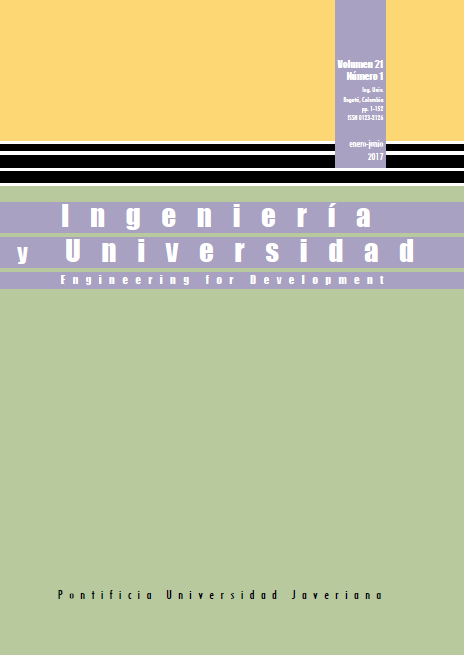Abstract
Introduction: this study focuses on determining the conditions that guarantee scalability in a hierarchical architecture based on the resources available in the different layers of the network. Methods: a model based on the truncated geometric distribution that allows the characterization of the available resources in an ad hoc network was proposed. From this characterization, the concept of growth factor j was introduced as a constant value that represents the appropriate relationship from among the available resources in two successive layers of the network to ensure scalability. The ns-3 software was used to develop simulation scenarios that were explored to develop the estimation process of the growth factor j in the ad hoc networks of two- and three-layer hierarchical architectures. Results: The results showed that the growth of resources among the layers in an ad hoc network can be expressed in a linear model. Moreover, a relation was found between the estimated value of j and the golden ratio as a way to inspire the design of artificial systems based on attributes that can be found in nature.
[2] J. Ospina, H. Zarate, and J. Ortiz, “Scalability in ad hoc networks under hierarchical architectures,” In Communications and Computing (COLCOM), 2015 IEEE Colombian Conference on (pp. 1-6). IEEE, 2015.
[3] P. Ghosekar, G. Katkar, and P. Ghorpade, “Mobile ad hoc networking: imperatives and challenges,” IJCA Special Issue on MANETs, vol. 3, pp. 153-158, 2010.
[4] J. Loo, J. Mauri, and J. Ortiz, Mobile ad hoc networks: current status and future trends. Boca Raton: CRC Press, 2016.
[5] S. Reddy, D. Estrin, and M. Srivastava, Emerging Wireless Technologies and the Future Mobile Internet. Cambridge: Cambridge University Press, 2011.
[6] D. Raychaudhuri and N. Mandayam, “Frontiers of wireless and mobile communications,” Proce. IEEE, vol. 100, no. 4, pp. 824-840, 2012.
[7] D. Tschopp, S. Diggavi, and M. Grossglauser, “Hierarchical routing over dynamic Wireless networks,” In ACM SIGMETRICS Performance Evaluation Review, vol. 36, no. 1, pp. 73-84, 2015.
[8] P. Gupta and P. Kumar, “The capacity of wireless networks,” IEEE Trans. Inf. Theory, vol. 46, no. 2, pp. 388-404, 2000.
[9] J. Yu and P. Chong, “A survey of clustering schemes for mobile ad hoc networks,” IEEE Commun. Surveys Tuts., vol. 7, no. 1, pp. 32-48, 2005.
[10] K. Abboud and W. Zhuang, “Stochastic modeling of single-hop cluster stability in vehicular ad hoc networks,” IEEE Trans. Veh. Technol., vol. 65, no. 1, p. 226-240, 2016.
[11] J. Ospina and J. Ortiz, “Scalability in ad hoc networks: the effects of its complex nature,” Int. J. Eng. Technol., vol. 3, no. 3, p. 315, 2014.
[12] M. Grossglauser and D. Tse, “Mobility increases the capacity of ad-hoc wireless networks,” Twentieth Annual Joint Conference of the IEEE Computer and Communications Societies Proceedings. IEEE, vol. 3, pp. 1360-1369, 2001.
[13] R. Ramanathan, R. Allan, and P. Basu, “Scalability of mobile ad hoc networks: Theory vs practice,” In Military Communications Conference, 2010-MILCOM 2010 (pp. 493-498). IEEE, 2010.
[14] D. Palma and M. Curado, “Scalability and routing performance of future autonomous networks,” Int. Journal Internet Protocol Technol., vol. , no. 3, pp. 137-147, 2013.
[15] A. Boukerche, B. Turgut, N. Aydin, M. Ahmad, and L. Bölöni, “Routing protocols in ad hoc networks: a survey. Computer Networks, vol. 55, no. 13, pp. 3032-3080, 2011.
[16] I. Ouafaa, L. Jalal, K. Salah-ddine, and E. H. Said, “The comparison study of hierarchical routing protocols for ad-hoc and wireless sensor networks: A literature survey,” Proceedings of the the International Conference on Engineering & MIS 2015, 2015, p. 32.
[17] M. Chatterjee, S. Das, and D. Turgut, “WCA: A weighted clustering algorithm for mobile ad hoc networks,” Cluster Computing, vol. 5, no. 2, pp. 193-204, 2002.
[18] W. Zhu, D. Gao, A. Fong, and F. Tian, “An analysis of performance in a hierarchical structured vehicular ad hoc network,” Int. J. Distributed Sensor Networks, p. 969346, 2014. http://dx.doi.org/10.1155/2014/969346
[19] S. Ross, Introduction to probability models, New York: Academic Press, 2014.
[20] V. Iversen, Teletraffic engineering and network planning, Lyngby: Technical University of Denmark, 2015.
[21] G. Riley and T. Henderson, “The ns-3 network simulator,” In Modeling and Tools for Network Simulation (pp. 15-34). Berlin: Springer-Heidelberg, 2010.
[22] S. Searle, Linear models, New York: Springer, 1971.
[23] T. Clausen, P. Jacquet, C. Adjih, A. Laouiti, and P. Minet, “Optimized link state routing protocol (OLSR),” (no. RFC 3626), 2003.
[24] A. Mood, Introduction to the Theory of Statistics, New York: McGraw Hill, 1950.
This journal is registered under a Creative Commons Attribution 4.0 International Public License. Thus, this work may be reproduced, distributed, and publicly shared in digital format, as long as the names of the authors and Pontificia Universidad Javeriana are acknowledged. Others are allowed to quote, adapt, transform, auto-archive, republish, and create based on this material, for any purpose (even commercial ones), provided the authorship is duly acknowledged, a link to the original work is provided, and it is specified if changes have been made. Pontificia Universidad Javeriana does not hold the rights of published works and the authors are solely responsible for the contents of their works; they keep the moral, intellectual, privacy, and publicity rights.
Approving the intervention of the work (review, copy-editing, translation, layout) and the following outreach, are granted through an use license and not through an assignment of rights. This means the journal and Pontificia Universidad Javeriana cannot be held responsible for any ethical malpractice by the authors. As a consequence of the protection granted by the use license, the journal is not required to publish recantations or modify information already published, unless the errata stems from the editorial management process. Publishing contents in this journal does not generate royalties for contributors.



